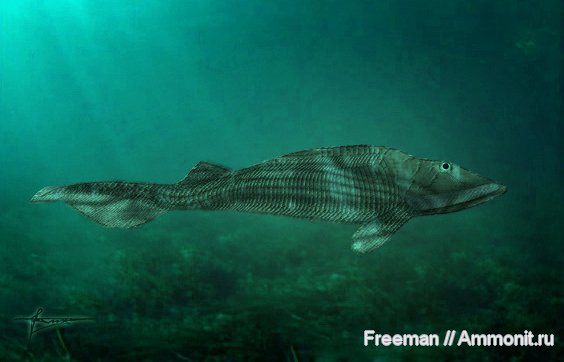
| Palaeos: |  |
Cephalaspidomorphi |
| The Vertebrates | Overview |
| Page Back | Unit Home | Unit Dendrogram | Unit References | Taxon Index | Page Next |
| Unit Back | Vertebrates Home | Vertebrate Dendrograms | Vertebrate References | Glossary | Unit Next |
|
Abbreviated Dendrogram
Vertebrata |--Conodonta `--+--Pteraspidomorphi `--Thelodonti `--+--+--Katoporida | `--Cephalaspidomorphi | |--Galeaspida | | |--Eugaleaspidiformes | | `--Polybranchiaspidida | `--+--Pituriaspida | `--+--Osteostraci | | |--Ateleaspis | | `--Cornuata | `--Gnathostomata | |--Placodermi | `--Acanthodii (paraphyletic) | |--Chondrichthyes | `--Osteichthyes `--+--Loganiidae `--Gnathostomata (alternative placement) |
Contents
Overview |
 |
The name Cephalaspidomorphi was used to include three distinct groups of jawless fish (agnatha), such as osteostracans, anaspids, and lampreys, in the 1920s (by Johan KiŠr and Stensi÷) on the basis of a shared single dorsal "nostril", called a nasohypophysial opening. As late as the 1980s, Carroll divided the Class Agnatha into two subclasses, the Pteraspidomorphi or Diplorhina, with two nostrils, and the Cephalaspidomorphi, or Monorhina as they are also called, with a single nostril. Both these groups are now known to be artificial as originally defined. The thelodonts, previously included in the Pteraspidomorphi, are most likely a paraphyletic group, while both the lampreys and anaspids are far more primitive (basal in cladistic jargon) than the osteostraca. Removing those groups from the latter taxon leaves the Cephalaspidomorphi with three groups that are almost certainly closely related: these are the Cephalaspidiforms or Osteostraca proper, a group of bizarre endemic Chinese forms called Galeaspida, and the poorly known and equally bizarre Pituriaspida, from Australia (which during the mid Palaeozoic was still Gondwana). Come to think of it, even the common run of the mill osteostracans were pretty bizarre looking craetures as well, as the above illustration and others show.
The current emerging consensus is that the Cephalaspidomorphi as more recently defined is acttually the parent clade of the jawed vertebrates (gnathostomes) (Janvier2008, Sansom, 2009). At some point these creatures lost their heavy head shield exoskeleton (or not, in the case of the placoderms) and become vaguely ray-like craetures, at first retaining the bottom dwelling habits of their jawless ancestors, but soon radiating out into a diverse range of morphologies, guilds, and ecological niches.
Interestingly, thelodonts, a broad and rather amorphous assemblage that seem to include the ancestors of the cephalaspidomorphs, counted among their number certainly highly specialised forms that were amazingly fish-like in appareance. Weere these the true ancestors of gnathostomes? It wouldn't be hard to make the transition from loganiid thelodont to acanthodian; according to this hypothesis, paired fins and gnathostome-like bone evolved several times, and the placoderms would be a side group who secondarily acquired a heavy armoured bottom-dwelling lifestyle. But if the cephalaspidomorphs are the ancestors of the higher vertebrates, that means that an active, fish-like lifestyle and morphology evolved by convergence at least twice, something that is not at all unlikely, especially considering that Coleoidan cephalopods also converge with fish in many respects, and they belong to a different phylum (Packard 1972 and page)
| Page Back | Unit Home | Glossary | Page Top | Page Next |